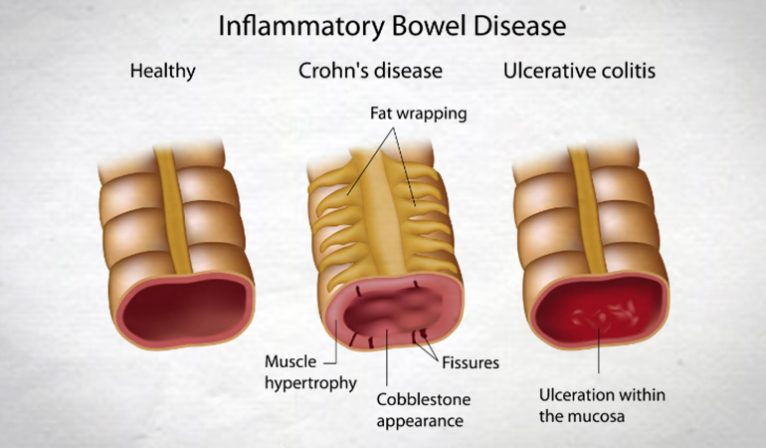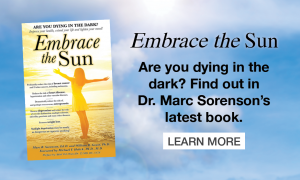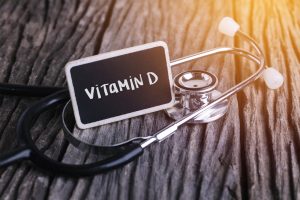Sunshine and gut inflammation by Marc Sorenson, EdD
Sunshine dampens chronic gut inflammation: Crohn’s and ulcerative colitis.

Sunshine helps to reduce chronic gut inflammation, which is usually due to two diseases: Crohn’s disease (CD) and ulcerative colitis. These two diseases are known as inflammatory bowel diseases (IBD), and worldwide, there are 800,000 people who live with those two life-long disorders. And, these diseases are autoimmune diseases, where the body attacks itself.
In addition, these diseases are hard to live with because they cause diarrhea, abdominal pain, inflammation and general misery. Each year more children contract IBD and each year, they contract it at younger ages. Most noteworthy, in my opinion, is the fact that IBD is, to a great extent, a sunshine deprivation disease. Children’s sunshine deprivation is horrific because it is child abuse, due to erroneous messages of dermatologists, AKA the Powers of Darkness.
Especially relevant is the fact that sunshine may profoundly decrease IBD. And, new research shows that the anti-inflammatory effects of sunshine are remarkably helpful.[1]
And here are the salient messages of this new sunshine research:
- First of all, children who were outside and exposed to sunshine for an extra half hour a day were protected. Thus, they had a 20% lower risk of developing IBD.
- Another finding was reported by Dr. Robyn Lucas, the lead researcher. Each 10 minutes of sun exposure was associated with a six% lower risk of developing IBD, [so do you want to deprive your children of sun exposure?]
- She also stated: “At this stage what we have shown is there is a link between lack of sun exposure and increased risk of IBD…”
- Furthermore, Dr. Lucas made this observation: “Taking children to play outside in the sun could be life-changing.”
Also, I should add that what is true for these children is also true for adults. Read more in the new book, Embrace the Sun, by Marc Sorenson and William Grant. https://www.amazon.com/Embrace-Sun-Marc-B-Sorenson/dp/069207600X

Find more information on http://sunlightinstitute.org/, particularly at this link: http://sunlightinstitute.org/low-levels-of-sunlight-exposure-predispose-to-inflammatory-bowel-disease-and-fractures/
So be sure to obtain regular, non-burning sunshine, whether for yourselves or your children. Happy sunning!
[1] Holmes EA, Ponsonby AL, Pezic A, Ellis JA, Kirkwood CD, Lucas RM. Higher Sun Exposure is Associated with Lower Risk of Pediatric Inflammatory Bowel Disease: A Matched Case-Control Study. Journal of Pediatric Gastroenterology and Nutrition, 2019; May 15 (Epub ahead of print).
First of all, let’s define IBD:
Inflammatory bowel diseases (IBD) are known as Crohn’s disease (CD) and Ulcerative Colitis (UC). UC is a chronic inflammatory condition characterized by relapsing and remitting episodes of inflammation limited to the mucosal layer of the colon.[1] Crohn’s however, can involve any part of the gastrointestinal tract from the mouth to the anus, but most commonly affects the small intestine or the colon, or both.[2]
New Italian Research
Research from Italy, published in December, 2017, shows that inadequate sun exposure is associated closely with IBD.[3] The researchers demonstrated that “Patients with IBD are significantly less exposed to sunlight then controls in our Mediterranean Country, often to an extent that may impair Vitamin D activation.” Consequently, they suggest that increased sun exposure may prove beneficial to patients.
Other research:
Furthermore, in a 12-year investigation of hundreds of thousands of IBD patients, the following was found: Hospitalizations and prolonged hospitalizations for both UC and CD were higher among those who had low sun exposure, compared to those with very high sun exposure.[4] In addition, the same relationship was shown between sun exposure, bowel surgeries and deaths: more surgeries were needed for those IBD patients who experienced the lowest sun exposure compared to those who had the highest sun exposure, and more deaths occurred among those with low exposure.
Does sun exposure help other diseases?
Furthermore, an interesting side note to the aforementioned investigation was the large number of non-IBD patients analyzed for sun exposure levels. Most noteworthy was the finding that the same relationship existed as with the IBD patients—low sun exposure was associated with prolonged hospitalizations and more deaths when compared with high exposure. Therefore, sun exposure saves lives, whether by decreasing IBD or preventing the myriad additional diseases that we have previously discussed.
In conclusion, if you have a painful feeling deep in your gut, take action: First of all, get a diagnosis. But do it while simultaneously increasing your safe, non-burning sun exposure. It may be just what the doctor ordered!
[1] Peppercorn M, Cheifetz, A, Rutgeerts P, Grover S. Definition, epidemiology, and risk factors in inflammatory bowel disease. http://www.uptodate.com/contents/definition-epidemiology-and-risk-factors-in-inflammatory-bowel-disease.
[2] Web MD http://www.webmd.com/ibd-crohns-disease/crohns-disease/inflammatory-bowel-syndrome.
[3] Vernia P, Burrelli Scotti G, Dei Giudici A, Chiappini A, Cannizzaro S, Afferri MT, de Carolis A. Inadequate Sunlight Exposure in Patients with Inflammatory Bowel Disease. J Dig Dis. 2017 Dec 18. doi: 10.1111/1751-2980.12567. [Epub ahead of print]
[4] Limketkai BN, Bayless TM, Brant SR, Hutfless SM. Lower regional and temporal ultraviolet exposure is associated with increased rates and severity of inflammatory bowel disease hospitalization. Aliment Pharmacol Ther. 2014 Sep;40(5):508-17.
 New research from New Zealand shows that children who live in South Island of New Zealand have at least three times the risk of bowel disease such as Crohn’s disease (CD) and ulcerative colitis (UC)[1] when compared to those who live on the North Island. According to an article referencing this research, these bowel diseases usually appear in the pre-teen or teenage years and are incurable. The researchers believe that sun exposure and one of its photoproducts, Vitamin D, may play a part, although the low selenium content of the soil may also have an influence on bowel diseases.
New research from New Zealand shows that children who live in South Island of New Zealand have at least three times the risk of bowel disease such as Crohn’s disease (CD) and ulcerative colitis (UC)[1] when compared to those who live on the North Island. According to an article referencing this research, these bowel diseases usually appear in the pre-teen or teenage years and are incurable. The researchers believe that sun exposure and one of its photoproducts, Vitamin D, may play a part, although the low selenium content of the soil may also have an influence on bowel diseases.
In the southern hemisphere, of course, the farther south one travels, the colder and cloudier the weather becomes. Hence, the South Island has far less sun exposure than the North Island.
Although the researchers did not know for sure that the sunlight and vitamin D hypothesis was correct regarding bowel disease, their idea certainly has plenty to back it up. Crohn’s disease is closely correlated to vitamin D deficiency and winter season,[2] indicating an inverse relationship with sun exposure and vitamin D production. A study of female nurses in the US found that “compared with women residing in northern latitudes [in the northern hemisphere] at age 30, the multivariate-adjusted risk for UC for women residing in southern latitudes was less than half.”[3] Also, in a 12-year investigation of hundreds of thousands of bowel disease patients, hospitalizations, and prolonged hospitalizations, for both UC and CD were higher among those who had low sun exposure compared to those with very high sun exposure.[4]
It is important to understand that bowel disease causes malabsorption of nutrients in the gut, leading to diseases of malnutrition.[5] Vitamin D is one of the “nutrients” that may not be absorbed efficiently, and therefore sun exposure, not supplements, may be the only viable source of vitamin D for a person with bowel disease.
So for a healthy gut, sun exposure plays a vital role. Be sure to enjoy safe, non burning sun exposure whenever possible.
[1] http://www.radionz.co.nz/news/national/340048/shining-light-on-bowel-disease-rates
[2] Gilman J, Shanahan F, Cashman KD. Determinants of vitamin D status in adult Crohn’s disease patients, with particular emphasis on supplemental vitamin D use. Eur J Clin Nutr. 2006 Jul;60(7):889-96.
[3] Khalili H, Huang ES, Ananthakrishnan AN, Higuchi L, Richter JM, Fuchs CS, Chan AT. Geographical variation and incidence of inflammatory bowel disease among US women. Gut. 2012 Dec;61(12):1686-92.
[4] Limketkai BN, Bayless TM, Brant SR, Hutfless SM. Lower regional and temporal ultraviolet exposure is associated with increased rates and severity of inflammatory bowel disease hospitalization. Aliment Pharmacol Ther. 2014 Sep;40(5):508-17.
[5] Margulies SL, Kurian D, Elliott MS, Han Z. Vitamin D deficiency in patients with intestinal malabsorption syndromes–think in and outside the gut. J Dig Dis. 2015 Nov;16(11):617-33.
By Marc Sorenson, EdD, Sunlight Institute..
Inflammatory bowel diseases (IBD) include diseases such as Crohn’s disease and ulcerative colitis. Like multiple sclerosis, lupus and rheumatoid arthritis, they are autoimmune diseases that cause the immune system to attack its own tissue, in this case the tissues of the digestive system. This may cause extreme distress and damage.
Recent research shows that the IBD is associated with both sun exposure and vitamin D deficiency.[1] In experimental IBD, vitamin D positively influences gut epithelial cells, innate immune cells, T cells, and the microscopic organisms that live in the gut. Separately from vitamin D, there is some scientific work that demonstrates that ultraviolet radiation (UVR), a component of sun exposure, can independently reduce IBD cells.
The authors of this research sum up their research with the following statement: “Together the data suggest that UVR suppression of T cells and potentially IBD are both vitamin D dependent and independent.”
Of course, we know that the natural way to obtain vitamin D is through sun exposure, so to me it appears that sun exposure, or sunlamp exposure, when available is the best method of suppressing the disease. Of course, proper nutrition is also imperative.
Many previous investigations have shown the remarkable positive influence of sun exposure on IBD. In a 12-year year investigation of hundreds of thousands of IBD patients, hospitalizations and prolonged hospitalizations were higher among those who had low sun exposure compared to those with very high sun exposure.[2] The same relationship was shown between sun, bowel surgeries and deaths; more surgeries were needed for those patients who experienced the lowest sun exposure compared to those who had the highest sun exposure, and more deaths occurred among those with low exposure.
An interesting side note to this investigation was that a large number of non-IBD patients were also analyzed for sun exposure amounts. The same relationship existed as with the IBD patients; low sun exposure was associated with prolonged hospitalizations and more deaths when compared with high exposure. There is other research involving the association of Crohn’s disease to sun exposure, which, as above, found that surgery for the disease was significantly reduced among those patients who received more sun exposure.[3]
It has also been shown that in the US, there is a north-south gradient for IBD,[4] [5] [6] [7] meaning that the risk of developing IBD is significantly lower for the southern latitudes (where sun exposure is greater). So for a healthy gut, sun exposure plays a vital role. Be sure to get some sun exposure daily when available. That way, you will obtain your vitamin D, along with other photoproducts that may protect you from IBD as well as myriad other diseases.
[1] Bora S, Cantorna MT. The role of UVR and vitamin D on T cells and inflammatory bowel disease. Photochem Photobiol Sci. 2016 Sep 8. [Epub ahead of print].
[2]Limketkai BN, Bayless TM, Brant SR, Hutfless SM. Lower regional and temporal ultraviolet exposure is associated with increased rates and severity of inflammatory bowel disease hospitalization. Aliment Pharmacol Ther. 2014 Sep;40(5):508-17.
[3]Govani SM, Higgins PD, StidhamRW,Montain SJ, Waljee AK.Increased ultraviolet light exposure is associated with reduced risk of inpatient surgery among patients with Crohn’s disease.J Crohns Colitis. 2015 Jan;9(1):77-81
[4] Schultz M1, Butt AG. Is the north to south gradient in inflammatory bowel disease a global phenomenon? Expert Rev Gastroenterol Hepatol. 2012 Aug;6(4):445-7.
[5]Kappelman MD, Rifas-Shiman SL, Kleinman K, Ollendorf D, Bousvaros A, Grand RJ, Finkelstein JA. The prevalence and geographic distribution of Crohn’s disease and ulcerative colitis in the United States. Clin Gastroenterol Hepatol. 2007 Dec;5(12):1424-9.
[6]Sonnenberg A. Similar geographic variations of mortality and hospitalization associated with IBD and Clostridium difficile colitis. Inflamm Bowel Dis. 2010 Mar;16(3):487-93.
[7]Holmes EA, Xiang F, Lucas RM. Variation in incidence of pediatric Crohn’s disease in relation to latitude and ambient ultraviolet radiation: a systematic review and analysis.Inflamm Bowel Dis. 2015 Apr;21(4):809-17
